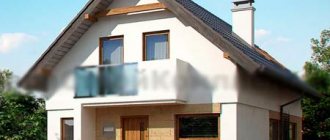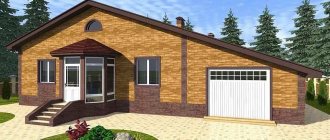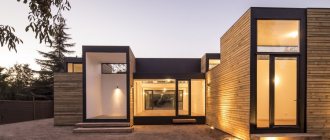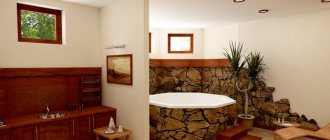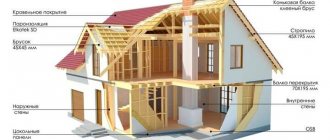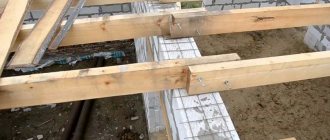When building a private house, when deciding on the height of the ceilings, many intuitively make a choice in favor of the standard one.
It will be possible to understand how expedient this decision is only after finishing the construction of the house and living in it. But you can understand some of the nuances and evaluate the pros and cons at the planning stage.
Accepted Standards
It is necessary to take into account, first of all, some existing regulations and standards. In addition to purely practical standards, depending on the complexity of the work and cost, there is a legally formalized set of SNiP (building codes and regulations). This document establishes the minimum permissible height of a residential premises, based on fire safety and the safety of the structure of the structure.
According to him:
- the height of rooms and kitchen areas should not be lower than 2.5 m;
- height of corridors and halls – 2.1 m;
- the height of the attic depends on the angle of inclination and is 1.3 m at an angle of 30° and is not standardized at an angle of 45° or more.
Making the height smaller will not only be uncomfortable, but also unsafe.
The minimum height normalized by the rules is not always optimal. Builders have their own standards, supported by experience and knowledge of the matter. Of course, everything depends on each specific case.
For example, for a luxurious stone mansion you should not make ceilings of the same height as for a modest wooden house in the village, but, based on the average size of a brick or wooden cottage, the standard height is 2.7-2.9 m.
This number allows you to find a balance between oppressive low ceilings and expensive high ones. Most country houses are built following this standard. And for good reason: standard height has huge advantages that many do not notice.
So how many floors should we build?
It is definitely necessary to build 2 floors (with or without an attic) in the following cases:
- you need a house larger than 200 square meters;
- the area of land allocated for construction is (or less) 6-8 hundredths of a hectare;
- the family has the necessary funds to order a good staircase and call for special equipment for the floors.
It is worth limiting yourself to one floor in the following cases:
- the land plot is 8 or more acres;
- there is no possibility of adjusting heavy equipment for installing reinforced concrete floor slabs;
- limited construction budget;
- With proper planning, all the necessary premises and living rooms are harmoniously located on the same level.
The beautiful facade of a one-story house is a design feature of such buildings. The building area is larger, but construction is cheaper than a house of the same footage on two floors. Source vip-1gl.ru
The result is that building a two-story house will be more expensive than a one-story house of the same size due to the need for the following elements:
- one more bathroom;
- stairs;
- ceilings
Advantages and disadvantages of standard height
The average value when building a private country house is most often optimal. When the goal is to build comfortable housing without extra costs and frills, the best solution is to follow the standards.
Disadvantages of high ceilings
- Building rooms with high ceilings costs much more and requires more material. This is especially true for two-story houses, so the ceilings on the second floor are usually lower than on the first.
- Due to the increase in the volume of the room, the cost of heating also increases.
- Very often this does not make any sense: a few tens of the upper centimeters remain unused, hanging over as unnecessary space.
Disadvantages of low ceilings
- Psychological feeling of tightness and discomfort.
- Difficulty in choosing furniture and fittings. It is necessary to choose furniture in such a way that it does not compress the space and does not cause inconvenience.
Choosing a standard height will allow you to bypass all these disadvantages and make your stay in the house as pleasant as possible.
Video description
To see the choice between a one- and two-story house, watch the video:
A staircase in a house with two or more floors is a separate big problem:
if it is well made and gently sloping, it can “pull” up to 20% of the total cost of construction of one floor; not everyone is comfortable using it - small children and elderly people often fall from them due to carelessness and get injured; the presence of a flight of stairs steals space on both the first and second floors, and the room where it is located automatically turns into an additional hall - the usable area becomes less and less.
Multi-level residential buildings also have useful aspects. Such houses can easily fit into 1/6 of a small plot of land of 6 acres; there will still be room for landscaping and some local areas.
Two-story houses are well suited for large families with children - everyone has their own room. Many people, even at the planning stage, include a balcony leading from the attic or second floor into the project. This decision will seem correct to the owners even 10 years after moving in, if the place where it is located offers a beautiful view.
The facade of a two-story house with an attic floor is an excellent solution for rational use of space. Source moydom.net.ua
Peculiarities
There are different nuances, and the standard height is not always the best. To build a simple, cheap, but at the same time comfortable and cozy house - of course, but in cases where it is important to make the house also unusual, eye-catching, intricate, it is better to act differently.
The standard height is optimal, average in all respects , but this is its main drawback if the goal is to build something unique. In addition, for different special cases there are private approaches.
In the case of building a frame house, the height is usually made smaller, lowering the ceilings to 2.3-2.5 m.
For example, in Finland, most houses are built this way. This is explained by the speed of construction of the structure and savings. But nevertheless, life in such houses is no less pleasant: by becoming more cramped, the housing acquires more comfort.
It is quite easy to build brick houses and increase them by a couple of tens of centimeters; moreover, with proper insulation, they are easy to heat, so the ceilings in such houses can be made higher . By raising the height to 3-3.2 m, you can attract interesting design solutions and achieve a modern, beautiful interior design.
Criteria on which the height of the ridge of a 2-pitched roof depends
Strictly speaking, calculating the roof height is a calculation of the optimal angle of inclination, which is selected based on several factors.
Precipitation
In principle, rain is not the type of precipitation that can linger on the roof: even a minimal slope is enough for the water to flow to the ground. Another thing is snow. If there is a lot of it and it is sticky, then if the angle of inclination of the slope is insufficient, it will accumulate on the surface of the roof, threatening to collapse it. Therefore, for northern regions, sloping roofs are bad; the slope angle should be at least 45°. In areas with little snow, this value can be much lower, up to 20°.
Wind load
Strong winds are a factor that also cannot be ignored. Powerful air masses moving at high speed can cause significant damage to the roof, tending to destroy it, and here a large slope angle is undesirable, since it increases the windage of the structure. The flatter the slope, the less pressure the winds will exert on the roof. So in windy regions the recommendations are the opposite - the flatness should not exceed 20°.
Roofing material
It would seem that the height of the roof should not depend on the roofing material used, but this is not the case. The smaller the area of a roofing unit, the greater its steepness should be: a small tile will have many more connecting elements that will serve as support for the snow than, for example, slate; the roughness of the surface also matters: on a smooth surface, snow has less chance of sticking. The specific gravity of the material also matters: for example, natural tiles themselves are much heavier than metal tiles or ondulin.
Typically, the packaging of the roofing material indicates the recommended angle of inclination, from which the height of the roof can be calculated.
Bearing capacity, material costs
The higher the roof, the stronger the supporting structure must be, so the use of more massive beams for rafters or additional strengthening of the structure frame will be required. At the same time, more roofing material will be required, which will lead to an increase in the estimate for this item.
The need to create an attic
A pitched roof does not imply the presence of an attic, but such structures are usually equipped with buildings for utility purposes. A gable roof already presupposes the presence of some kind of attic space, but whether it will be used or not is another question.
Many people use the attic to store bulky and unnecessary items. In this case, it does not greatly affect the height of the roof. It’s another matter if you plan to use the attic space as a living space - in this case, you will have to take into account the convenience of living, so that you can walk to your full height in most of the room. However, there are also fire safety requirements for a storage attic: it must have a through passage at least 120 cm wide and 160 cm high.
Adviсe
To make the living space of a private home more aesthetically pleasing, there are many interior solutions that most people simply do not know about. For people who have chosen standard-height ceilings, the following recommendations can be given to add visual beauty and volume to the room:
- It is worth using shiny stretch ceilings - they stretch out the space, saturating it with reflected light;
- in the decoration of the walls you need to add more vertical lines and mirrors - this will make the space deeper and visually higher;
- It is advisable to paint the walls and ceiling in the same tone, and the floor a tone lower, that is, darker;
- It is better to make the ceiling light;
- Windows should be placed closer to the ceiling so that more light falls on it than on the floor.
Optimal overlap format
At the stage of construction work, every owner wants to make the optimal height of the rooms in his house. When choosing this option, you should take into account that you will have to take care of the house and spend resources on its maintenance
To choose the overlap format, it is important to adhere to:
- building standards;
- the owner's wishes;
- laws of ergonomics.
If everything is clear with the owner’s preferences, then you need to take a closer look at the ergonomics. The discipline teaches people how to effectively interact with the space around them. Therefore, for a cozy atmosphere in the building, ergonomic conditions are observed:
- sufficient amount of air;
- more natural light;
- comfortable microclimate.
In addition, the optimal height depends on the size of the rooms. The larger the room, the higher the walls. A room with a large area and a ceiling below the required level will put pressure on the surrounding space, while a small area and high ceiling will look ridiculous.
Some determine the required height this way: choose the tallest family member and make the ceiling 30 cm higher than his height at arm's length.
Pros and cons of high ceilings
High ceilings can create a feeling of abundance of oxygen and freedom, give the interior appearance of the house aristocracy, and create an incredible design.
However, if you decide to install high ceilings in your mansion, you need to take into account some disadvantages.
- Heating a room where the ceiling is high requires significant costs.
- The heat that accumulates at the top of the room gradually destroys the roofing materials and the space reserved for the attic.
- For tall buildings, construction costs and finishing materials increase.
- The ceiling height in premises intended for housing should not exceed 320 centimeters. Failure to comply with this parameter will lead to difficulties in maintaining the room (changing light bulbs, maintaining cleanliness).
Pros and cons of low ceilings
Low ceilings, although this is a relative concept, are considered a disadvantage of housing. For spacious rooms, a height of 280 cm may seem insufficient, but for a cozy bedroom a wall of 240 cm will be comfortable. It all depends on the size and proportions of the room.
The main disadvantages of low ceilings include:
- Unpresentable appearance.
- Limitation in the choice of lighting devices.
- Feeling of pressure.
- Difficulties in design. Stretch ceilings and suspended structures are difficult to install in a room with a low ceiling.
Design
The choice of standard-height ceilings opens up prospects for varied and inexpensive designs: from banal wallpaper (it is better to prefer wallpaper with stripes, as they make the appearance more sophisticated) to intricate designer patterns that can add interesting ideas to the interior of the room. Using a small ladder, you can independently reach the highest sections of the walls and decorate them.
A room with a standard ceiling height can be compared to a standard sheet of paper, so familiar to creativity. There are, of course, both large and small formats, but it is the standard one that is so familiar and convenient for creating something of your own.
How to obtain permission for individual housing construction? What does a developer need to know?
Limiting authorities follow the development procedure and approve documents for individual housing construction according to RSN 70-88. Thanks to them, not only the accuracy of site development is determined, but also the layout of the home and auxiliary buildings. This project needs to be carefully considered, because what is not shown in the plan will be recognized as an unauthorized structure and must be demolished or re-approved.
Without permission, that is, before the plan is approved and documents are received, work should not begin, otherwise serious problems may arise. In order to find out exactly what documents will be required to start construction, you should read the “Code of Rules for Design and Construction SP 11-III-99”.
In 2010, SNiPs were recognized as sets of mandatory rules. They regulate activities in the field of urban planning, as well as engineering work, design and construction.
In order to obtain permission, you need to contact the BTI or the city architectural department to provide:
- application for planning permission;
- documents establishing the right to use the site;
- certificate of field determination of boundaries, placement of buildings, etc.;
- cadastral plan of the site;
- House project.
Once issued, the permit is valid for 10 years.
Psychology
Houses are built for people and people to live in them, their feelings and impressions of living in a particular house are the main thing that should be guided by. A normal height is one that does not cause unpleasant emotions: it does not press, does not make you feel uncomfortable, but at the same time does not create the feeling of being in a public place.
Home is a place where you need to relax, feel in your place, and relax. Oddly enough, in this case, a lot depends on the height of the ceiling.
It must be remembered that rooms can be very multifunctional. For noisy parties you need one thing, for quiet libraries – another. The good thing about the standard height is that it can be adjusted to fit anything. In addition, this is absolutely a win-win option in cases where the exact purpose of the room is unknown. The feelings that a room makes you experience are the main thing that a room can give to a person.
Examples of successful projects
Before you plan your dressing room, you need to outline a detailed plan. To imagine in more detail what the room will look like, you can consider examples of successful bedroom layouts with dressing rooms of different sizes:
- For this corner type project, an area of 1.5 x 1.5 m is required. The place where things will be stored is separated from the main room by a plasterboard partition, which gives the maximum amount of free space with a minimum footage. For greater functionality, furniture is placed on two walls. The spiral-shaped jumper between the racks allows you to smooth out the corners and increases the usable space. The shelves are made open. The entrance is wide with a sliding door that completely opens the interior of the dressing room and allows you to conveniently try on things.
- The more spacious design is also angular in shape. The specificity of the project is the absence of partitions, and the space for placing clothes is an integral part of the room. By using shelving without doors, things are as open and accessible as possible.
- Another layout with the dimensions of a linear-type dressing room, with cabinets located near the wall. The length depends on the footage of the room. Width - 1.4–1.5 m. The living and dressing areas are separated by a plasterboard partition with a built-in sliding door with a mirror. Inside there are racks with drawers and shelves, and hanger bars. Open designs will save some space.
- The most spacious will be a U-shaped dressing room. A separate room with an area of at least 10 m2 is equipped for it. Various devices with a width of 0.5–0.6 m are installed on three sides. Such modules, despite their size, are quite spacious. They are convenient for storing various small items, as well as everyday items, bedding and even outerwear. Here, among other things, there is space for a built-in ironing board. A large mirror will be a must.
Linear
U-shaped
Corner 1.5 by 1.5 m
Corner
How is the exact height of a multi-story building determined?
The exact height of a 10-story building is determined on the basis of the project, which became the fundamental document for its construction. During the times of state standardization, the design of the series was carried out taking into account the building material used.
The construction of a panel house was designed to produce panels of certain parameters, the construction of a brick house was designed to produce products from brick factories in areas where there was no point in building large house-building enterprises.
A general, abstract, approximate answer to the question of how many meters high is a 10-story building may also contain discrepancies. For example, an approximate floor height defined as 3 m (including a standard flight of stairs) gives a figure of 30 m, which almost never corresponds to reality.
The height of a ten-story building in more accurate calculations requires taking into account several circumstances at once:
- The height of the ceilings, which in different series can vary from 2.64 to 3 m. In series 97 of the Brezhnev period, it is indicated in meters in exactly this range. It all depends on the region of construction and the number of floors in a large-panel house.
- Roof type. In the same 97 series, a flat, roll-free type was mainly used, but sometimes the project included a technical floor, an attic attic, and a roof with a slight slope. And this also plays a role in determining how many meters the vertical parameter will be.
- In addition to the precisely known height of the ceilings (the so-called interfloor space), the height of the interfloor ceilings is taken into account - a durable layer separating one floor from another.
It is necessary to take into account
The total height of a ten-story building is not only its residential part, but also:
You can succumb to temptation and follow stereotypical calculations, which are usually given in incompetent sources. For example, take it for granted that a 5-story building is 15 meters high, and calculate the dimensions of a 10-story building as two five-story buildings stacked on top of each other. However, if there is a need for reliable data, such calculations are unacceptable.
You can find out what the height of a particular house is only if you have official documents - a description of the series or a modern special project.
The latter is important, since new construction technologies, using monolithic concrete and excluding standard panel construction parts, allow ceiling heights of 3 meters or more.
Common types of Soviet-era buildings
In the terminology of realtors and those involved in renting out housing, terms constantly appear that are not always familiar to the average person. These are conditionally generalized names of buildings erected in one period or another, when construction was carried out at an accelerated pace. Initially, the construction of higher-rise buildings began with 4 and 5 floors, but over time, preference was given to the latter. They envisioned a larger number of separate apartments that could be given to people for resettlement.
An undeniable advantage, compared to even taller buildings, was the opportunity not to equip an elevator, and thus save additional money. According to construction standards, it was on the fifth floor that the opportunity to do without installing an elevator, its shaft, a lifting mechanism and further costs for repairs and maintenance ended.
History of 5-story buildings
Five-story houses began to be built in Moscow and St. Petersburg even before the war, but after its end, in 1948, the first attempts to build experimental houses began using frames and panels as standard parts for assembly.
By appearance and degree of wear and tear after use, one can quite easily distinguish between three periods of Soviet construction, which were popularly named after the names of the then leaders of the country.
Over time, they even took root in official documents, and now, when talking about projects, they use three common terms:
- “Stalin buildings” are houses that have retained a presentable and well-groomed appearance until now, because their service life was included in the design for 125 years or more. They can be easily distinguished by the presence of architectural decorations, stucco moldings, plinths, columns, Soviet paraphernalia, pompous style and the presence of high first floors for public spaces in street buildings. The ceilings in the apartments of such houses were more than 3 meters, since the planning took into account a certain volume of air for each resident. “Stalin buildings” were always more than 20 m high, due to the spans between floors and the strong roof that reliably protected the building.
- In a five-story panel house, the construction of which began under Khrushchev, the ceiling height was sometimes 2.48 m (all parameters depend on the standard project number). In order to save money, they first stopped building an iron frame, leaving only reinforced concrete panels; sometimes they did not make a full-fledged attic; in other options there was no basement. Later, the ceilings became a little higher, and then they reached their maximum height when designing the last series (2.64 m), but the roofs were no longer gable, but flat, there were no longer columns or plinths. However, for street buildings, the design with a higher ground floor was still used, in which premises were built for shops, organizations or public needs. Hence the approximate height of the Khrushchev building, which ranges from 14 to 15 meters.
- The construction of the Brezhnevka took place according to new, modified design documents. Although the Unified Construction Catalog of Parts was still used, such houses had wide landings, ceilings rose to 2.7 m, and almost everywhere there was a full attic and a deep basement. Even visually you can determine that the Khrushchev panel building is noticeably different from the Brezhnev building. Apart from the difference in height (even 20 cm in terms of five floors is a meter, not taking into account the attic and ceilings), there is also the appearance. The period for which the Khrushchev buildings were designed has completely expired, but the more solid construction still looks relatively normal.
The 5-story brick residential building of the Stalin and Khrushchev eras is also very different in visual perception. The Stalinist house had a foundation and a gable roof, which occupied about 6.5 m, and with the addition of ceiling heights, this figure starts from 21.5 m. Although everything also depends on the ceilings between the floors, and they were different. The height of the People's Commissar's Stalin could reach even higher levels. Brick Khrushchev buildings, where, for the sake of economy, there were no frills, and the ceiling height reached less than 2.5 m, could be 14 meters in vertical dimension.
Equipment
Initially, the client finds a favorable price for building a house on the website or in advertising. This is achieved by reducing the cross-sections of load-bearing structures, the thickness of the insulation layer, and simplifying the joints to the point of being impossible.
Despite the fact that all people are different, they are similar in their desire to ultimately obtain a reliable and safe home. This is what managers take advantage of. They offer to improve the equipment (sections of beams, rafters, floor height, etc.). Accordingly, the cost immediately increases, increasing by 1.5-2 times from the initial one. In order not to fall for this bait, we will analyze the main parameters of the 1st stage of construction of a wooden house.
Foundation
Shallow strip foundation
The diagram shows options for foundation sections offered by various contractors. By reducing the cross-section of the foundation, they reduce the cost. It is also possible that, with the same cross-section, a lower price is achieved due to the materials used in production and the amount of work. Below we have listed the main materials and work required when installing the foundation and our recommendations.
Concrete
It is advisable to take a concrete grade no lower than M300 (B 22.5). We use only factory certified concrete with the attached passport.
Armature
Corrugated reinforcement of at least 10mm in diameter is used (we use 12-14mm).
Waterproofing
We recommend waterproofing the base and side surfaces of the tape at the stage of formwork installation. You can use special films, roofing felt, waterproofing. We use roofing felt RKP-350. When pouring concrete, waterproofing retains moisture in the mixture, thereby improving the quality of the concrete as it hardens.
Formwork
For formwork, board or plywood is used. The most important thing is that the finished formwork retains its shape and integrity when poured. This is achieved by using pins, ties, jibs and other methods in the formwork construction.
Quarry sand
Used as a cushion under the foundation to reduce heaving under the base of the foundation.
Works
The standard scope of work when installing a foundation should be as follows:
- Geodesy,
- Digging a trench,
- Installation of formwork with waterproofing and ventilation ducts,
- Knitting of reinforcement cage,
- Reception of concrete. If access to the formwork is difficult, a concrete pump is usually used to supply concrete to the formwork,
- Dismantling of formwork,
- Removing the fertile layer of soil inside the foundation.
- Delivery of all materials to the site with unloading.
